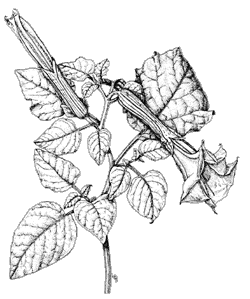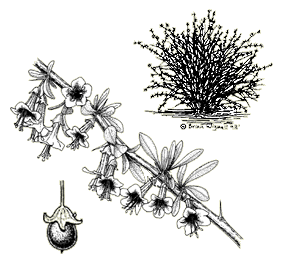Solanaceae (nightshade family)
The nightshade family has about 2600 species worldwide and includes herbs, shrubs, trees, and vines. While many are highly poisonous (deadly nightshade, Jimson weed) others are major food crops such as potatoes, tomatoes, and chile peppers. Tobacco is an extremely toxic plant that is grown in huge quantities for two uses: as an addictive drug essential in maintaining cigarette sales and as an important agricultural insecticide. In both products the active ingredient is nicotine. Several useful pharmaceutical drugs are derived from various species of nightshades.
 |
Datura wrightii [D. meteloides]
English names: sacred datura, jimson weed, angel’s trumpet, devil’s weed
Spanish names: toloache grande, tecuyaui, belladona
Description
Jimson weed (its most widespread English name) is a perennial herb 2 to 5 feet (0.60-1.5 m) tall and up to several feet (a couple of meters) wide from a large tuberous root. The foliage is dark green and sticky with an unpleasant odor when crushed. Big funnelform, white flowers are 6 inches long and 3 inches wide (15 x 8 cm); they open by dusk and emit a strong, sweet fragrance. The bloom is sporadic throughout the warm months if soil moisture is present, but it flowers most heavily in late summer. The spiny, golf-ball-sized fruit contains numerous disk-shaped seeds.
Range
Jimson weed occurs from central California to Texas and Mexico and into northern South America.
Notes
All parts of these plants contain numerous toxic alkaloids. One of them is scopolamine, a common ingredient in cold and nausea remedies. Shamans in various cultures have ingested datura to induce visions. This is one of the most dangerous plants used for this purpose, because not only do individual plants vary in potency, but humans also differ in their tolerance to the toxins. Despite widely-published warnings, every year a few people suffer life-threatening poisoning from eating this plant; some of them don’t survive.
This beautiful plant is a useful ornamental if there is sufficient space for its large size and one is willing to put up with its winter disappearance below ground. Hawkmoths pollinate the flowers and lay eggs on the foliage. The caterpillars (called “hornworms” in this family) incorporate the plant’s toxins into their own tissues and become toxic to their potential predators.
It would seem that a desert plant should not have such large leaves. But it grows them during the hottest weather and even when there seems to be little soil moisture available. See Plant Ecology chapter for a discussion.
Datura wrightii is our only perennial datura. Datura discolor (desert thorn apple, toloache) and D. stramonium (jimson weed, hierba del diablo—“herb of the devil”) are annuals with smaller dimensions.
Lycium spp.
English names: wolfberry, boxthorn
Spanish names: frutilla (generic);
L. berlandieri: barchata, josó, hosó
cilindrillo, tomatillo
Description
The several species of Lycium in our region are all densely-branched and usually spiny shrubs that are leafless during dry seasons. They range from about 2 feet (60 cm) to over 8 feet (2.4 m) tall and much wider, depending on species and water availability. Leaves are most commonly present during the cool season. Masses of small, greenish to purplish flowers are followed by pea-sized red berries resembling tiny tomatoes.
 |
Range
The 100 species of this cosmopolitan genus occur in warm-temperate and subtropical habitats. About 15 species occur in the Sonoran Desert.
Notes
Nearly every part of the Sonoran Desert has at least one species of Lycium. The structure of the flowers suggests bee pollination, and bees do visit them profusely, but butterflies and hummingbirds also visit in great numbers. Birds relish the fruits. People also highly value the small, tasty berries as a snack. The squeamish should be forewarned that the berries often have insect larvae inside them. This doesn’t bother the Seri, one of whom said “Those aren’t maggots, they’re just live things.”
Lac insects (Tachardiella spp.) can be found on wolfberries as well as on creosote bushes. A related species, the Indian lac insect, is harvested in huge quantities to make shellac and varnish.










